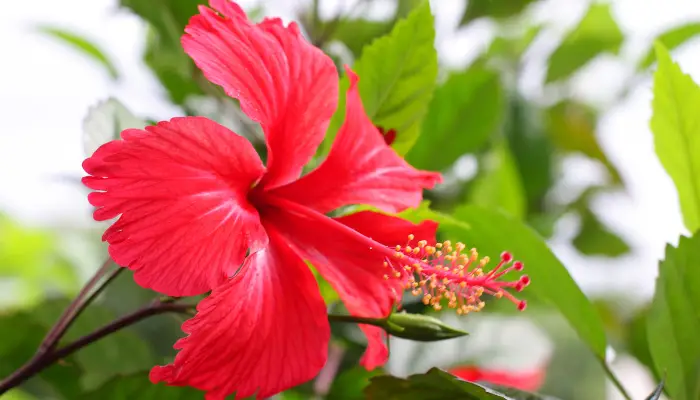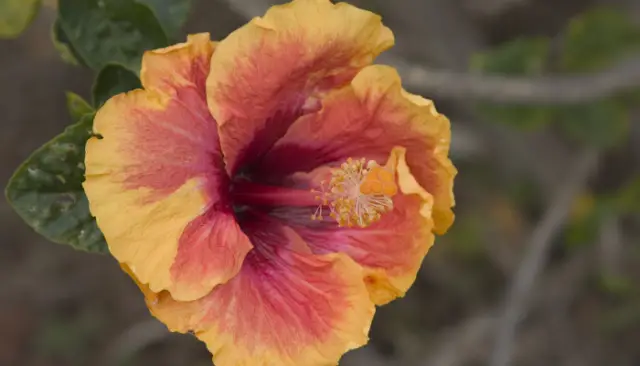Hibiscus are beautiful flowering plants that can add a tropical flair to any garden. They come in a variety of colors, shapes, and sizes, and they can attract hummingbirds and butterflies to your yard. But do hibiscus come back every year, or do you have to replant them every season?
The answer depends on the type of hibiscus you have. There are two main categories of hibiscus: perennial and tropical. The perennial (or hardy) hibiscus returns every year, while the tropical hibiscus is less likely to come back.
Perennial Hibiscus

Perennial hibiscus, also known as rose mallow or swamp mallow, are native to North America and can survive cold winters. They are hardy in zones 5 to 9, which means they can tolerate temperatures as low as -20°F. They die back to the ground in the fall, but they regrow from their roots in the spring. They usually bloom from midsummer to early fall, producing large, showy flowers that can be up to 12 inches across. Some popular varieties of perennial hibiscus are ‘Lord Baltimore’, ‘Kopper King’, ‘Midnight Marvel’, and ‘Summerific Berry Awesome’.
Perennial hibiscus are easy to grow and care for. They prefer full sun and moist, well-drained soil. They can tolerate some drought, but they will perform better if you water them regularly. They also benefit from a layer of mulch to conserve moisture and protect the roots from frost. You can fertilize them once or twice a year with a balanced fertilizer. You can prune them back to a few inches above the ground in late fall or early spring, or you can leave them alone and let them sprout naturally. You can also divide them every few years to prevent overcrowding and promote healthy growth.
Tropical Hibiscus

Tropical Hibiscus
Tropical hibiscus, also known as Chinese hibiscus or Hawaiian hibiscus, are native to Asia and the Pacific Islands. They are not cold-hardy and can only survive in zones 10 and 11, where the temperature rarely drops below freezing. They are evergreen shrubs that can grow up to 15 feet tall and wide. They bloom year-round, producing bright and colorful flowers that can be single or double, and have various shapes and patterns. Some popular varieties of tropical hibiscus are ‘President’, ‘Brilliant’, ‘Painted Lady’, and ‘Double Red’.
Tropical hibiscus are more demanding than perennial hibiscus. They need at least six hours of direct sun and warm, humid conditions. They also need regular watering and feeding with a high-potassium fertilizer. They are prone to pests and diseases, such as aphids, whiteflies, spider mites, mealybugs, scale, fungal infections, and bacterial wilt. You can control these problems by spraying them with insecticidal soap, neem oil, or horticultural oil, and by pruning away any diseased or damaged parts. You can also prune them lightly to shape them and encourage more blooms.
If you live in a cold climate, you can still enjoy tropical hibiscus by growing them in containers and bringing them indoors during the winter. You can place them in a sunny window or under artificial lights, and keep them away from drafts, heaters, and air conditioners. You can reduce watering and feeding during the winter, and resume normal care in the spring. You can also repot them every year or two to refresh the soil and provide more room for the roots.
Conclusion
Hibiscus are stunning plants that can brighten up any garden with their exotic flowers. Whether you choose perennial or tropical hibiscus, you can enjoy their beauty for years to come, as long as you provide them with the right conditions and care. Hibiscus are rewarding plants that will reward you with abundant blooms and joy.
Frequently Asked Questions on How to Grow and Care For Perennial and Tropical Hibiscus in Your Garden
How do I know if my hibiscus is perennial or tropical?
You can identify the type of your hibiscus by looking at its leaves, stems, and flowers. Perennial hibiscus have green, heart-shaped leaves, woody stems, and large, saucer-shaped flowers. Tropical hibiscus have glossy, dark green leaves, green stems, and smaller, trumpet-shaped flowers.
How often should I water my hibiscus?
You should water your hibiscus when the top inch of the soil feels dry to the touch. Perennial hibiscus need more water than tropical hibiscus, especially during hot and dry weather. You can check the soil moisture by inserting your finger or a wooden stick into the soil. If it comes out clean, the soil is dry and needs water. If it comes out moist or muddy, the soil is wet and does not need water.
How do I prune my hibiscus?
You can prune your hibiscus to shape them, remove dead or diseased branches, and encourage more blooms. Perennial hibiscus can be pruned back to a few inches above the ground in late fall or early spring, or you can leave them alone and let them sprout naturally. Tropical hibiscus can be pruned lightly throughout the year, but avoid pruning them in late fall or winter, as this can reduce their flowering in the next season.
How do I fertilize my hibiscus?
You can fertilize your hibiscus once or twice a year with a balanced fertilizer, such as 10-10-10 or 20-20-20. Perennial hibiscus can be fertilized in early spring and midsummer, while tropical hibiscus can be fertilized every month during the growing season. You can also use a high-potassium fertilizer, such as 10-30-20 or 15-30-15, to boost the flowering of your hibiscus. You can apply the fertilizer according to the package directions, and water well after fertilizing.
How do I protect my hibiscus from frost?
You can protect your hibiscus from frost by covering them with a frost cloth, a blanket, or a plastic sheet. You can also move your container-grown hibiscus indoors or to a sheltered location. Perennial hibiscus can survive some frost, but tropical hibiscus are very sensitive to cold and can be damaged or killed by frost. You should remove the coverings as soon as the temperature rises above freezing, and check for any signs of injury or disease.
How do I propagate my hibiscus?
You can propagate your hibiscus by seeds, cuttings, or division. Seeds can be collected from the dried pods of your hibiscus, and sown in pots or trays filled with moist potting mix. Cuttings can be taken from healthy stems of your hibiscus, and inserted in pots or trays filled with moist potting mix or sand. Division can be done by digging up your hibiscus, and separating the roots into smaller sections. You can plant the seeds, cuttings, or divisions in a sunny and warm location, and keep them moist until they root or sprout.
How do I deal with pests and diseases on my hibiscus?
You can deal with pests and diseases on your hibiscus by using organic or chemical methods. Organic methods include spraying your hibiscus with insecticidal soap, neem oil, or horticultural oil, which can kill or repel insects and mites. You can also use beneficial insects, such as ladybugs, lacewings, or parasitic wasps, which can feed on or parasitize the pests. Chemical methods include using synthetic pesticides, such as malathion, permethrin, or carbaryl, which can kill or control insects and mites. You should always follow the label instructions and safety precautions when using any pesticide, and avoid spraying your hibiscus when they are in bloom, as this can harm the pollinators. You can also prevent pests and diseases by keeping your hibiscus healthy, well-watered, and well-fertilized, and by removing any diseased or damaged parts.
How do I transplant my hibiscus?
You can transplant your hibiscus when they outgrow their pots or when you want to change their location. You should transplant your hibiscus in early spring or late summer, when the weather is mild and the plants are not in bloom. You should choose a pot or a spot that is slightly larger than the current one, and has good drainage. You should also use a fresh potting mix or soil that is rich in organic matter. You should water your hibiscus well before transplanting, and gently loosen the roots from the old pot or soil. You should place your hibiscus in the new pot or spot, and fill the gaps with the new potting mix or soil. You should firm the soil around the roots, and water well after transplanting. You should also apply a layer of mulch to conserve moisture and protect the roots.
How do I overwinter my hibiscus?
You can overwinter your hibiscus by bringing them indoors or by providing them with extra protection. Perennial hibiscus can be left outdoors in zones 5 to 9, as they can survive cold winters. You can apply a thick layer of mulch to cover the roots, and prune back the stems to a few inches above the ground. Tropical hibiscus can be brought indoors in zones below 10, as they cannot tolerate freezing temperatures. You can place them in a sunny window or under artificial lights, and keep them away from drafts, heaters, and air conditioners. You can reduce watering and feeding during the winter, and resume normal care in the spring.
How do I choose the best hibiscus for my garden?
You can choose the best hibiscus for your garden by considering your climate, your space, and your preference. You should choose a hibiscus that is suitable for your hardiness zone, and that can tolerate your weather conditions. You should also choose a hibiscus that fits your space, and that does not grow too large or too small for your garden. You should also choose a hibiscus that appeals to your taste, and that has the color, shape, and size of flowers that you like. You can browse online catalogs, visit local nurseries, or ask other gardeners for recommendations. You can also experiment with different varieties of hibiscus, and see which ones perform best in your garden.




